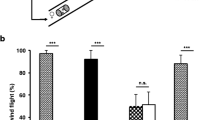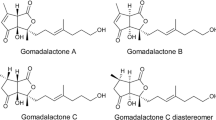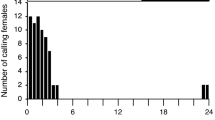Abstract
Behavioral and chemical evidence is presented for the identity of the male wing pheromone ofEphestia elutella (Hübner) and the role of this pheromone in courtship success is evaluated. Males with the forewing removed experienced a mating success rate less than half of that of either intact males or males that had only the wing gland area remaining of their forewings. GC-MS analysis and microchemical reactions indicated the presence of (E)-phytol and a series of saturated γ-lactones in a methylene chloride extract of the wings. Using an assay of female courtship behavioral response, (E)-phytol was found to evoke an intermediate level of response in females when presented alone, while the complete array of insect-derived γ-lactones produced no significant response. The combination of either γ-decalactone or γ-undecalactone with (E)-phytol in a 1∶2 ratio, however, elicited a female response equivalent to that produced by the unfractionated wing extract.
Similar content being viewed by others
References
Barth, R. 1937. Bau and Funktion der Flügeldrüsen einiger Mikrolepidopteren.Z. Wiss. Zool. 150:1–37.
Beroza, M., andBierl, B.A. 1967. Rapid determination of olefinic position in organic compounds in microgram range by ozonolysis and gas chromatography.Anal. Chem. 39:1131–1135.
Beroza, M., andSarmiento, R. 1966. Apparatus for reaction chromatography: Instantaneous hydrogenation of unsaturated esters, alcohols, ethers, ketones and other compound types, and determination of their separation factors.Anal. Chem. 38:1042–1047.
Bjostad, L.B., Linn, C.E., Du, J.D., andRoelofs, W.L. 1984. Identification of new sex pheromone components inTrichoplusia ni, predicted from biosynthetic precursors.J. Chem. Ecol. 10:1309–1323.
Burrell, J.W.K., Garwood, R.F., Jackman, L.M., Oskay, E., andWeedon, B.C.L. 1966. Carotenoids and related compounds. Part XIV. Stereochemistry and synthesis of geraniol, nerol, farnesol, and phytol.J. Chem. Soc. (C) 1966:2144–2154.
Corbet, S.A., andLai-Fook, J. 1977. The hairpencils of the flour mothEphestia kuehniella.J. Zool. 181:377–394.
Dettner, K., andSchwinger, G. 1982. Defensive secretions of three Oxytelinae rove beetles (Coleoptera: Staphylinidae).J. Chem. Ecol. 8:1411–1420.
Dickens, G.R. 1936. The scent glands of certain Phycitidae (Lepidoptera).Trans. R. Entomol. Soc. London 85:331–362.
Grant, G.G. 1976. Courtship behavior of a phycitid moth,Vitula edmandsae.Ann. Entomol. Soc. Am. 69:445–449.
Grant, G.G. 1978. Morphology of the presumed male pheromone glands on the forewings of tortricid and phycitid moths.Ann. Entomol. Soc. Am. 71:423–431.
Grant, G.G., andBrady, U.E. 1975. Courtship behavior of phycitid moths. I. Comparison ofPlodia interpunctella andCadra cautella and the role of male scent glands.Can. J. Zool. 53:813–826.
Honkanen, E., Moisio, T., andKarvonen, P. 1965. The mass spectra of some aliphatic lactones.Acta Chem. Scand. 19:370–374.
Howard, D.F., Blum, M.S., andFalses, H.M. 1983. Defense in thrips: Forbidding fruitiness of a lactone.Science 220:335–336.
Krasnoff, S.B., andVick, K.W. 1984. Male wing-gland pheromone ofEphestia elutella.J. Chem Ecol. 10:667–669.
McLaughlin, J.R. 1982. Behavioral effect of a sex pheromone extracted from forewings of malePlodia interpunctella.Environ. Entomol. 11:378–380.
Ryan, T.A. 1960. Significance tests for multiple comparison of proportions, variances, and other statistics.Psychol. Bull. 57:318–328.
Sims, J.J., andPettus, J.A. 1976. Isolation of freecis- andtrans-phytol from the red algaGracilaria andersoniana.Phytochemistry 15:1076–1077.
Still, W.C., Kahn, M., andMitra, M. 1978. Rapid chromatographic technique for preparative separations with moderate resolution.J. Org. Chem. 43:2923–2924.
Strong, R.G., Partida, G.J., andWarner, D.N. 1968. Rearing stored-product insects for laboratory studies: Six species of moths.J. Econ. Entomol. 61:1237–1249.
Wheeler, J.W., Happ, G.M., Araujo, J., andPateels, J.M. 1972. γ-Dodecalactone from rove beetles.Tetrahedron Lett. 46:4635–4638.
Willstätter, R., Schuppli, O., andMayer, E.W. 1919. Untersuchungen über Chlorophyll.Ann. Chem. 418:121–147.
Author information
Authors and Affiliations
Rights and permissions
About this article
Cite this article
Phelan, P.L., Silk, P.J., Northcott, C.J. et al. Chemical identification and behavioral characterization of male wing pheromone ofEphestia elutella (Pyralidae). J Chem Ecol 12, 135–146 (1986). https://doi.org/10.1007/BF01045597
Received:
Accepted:
Issue Date:
DOI: https://doi.org/10.1007/BF01045597




